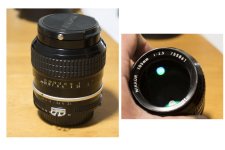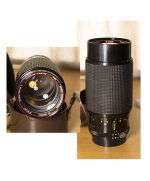Go grab a soda or a cup of coffee and a snack, this will take a little while!
The first lens is a 2.8 cm (28mm) f/3.5 very early auto, non-AI Nikkor. A very good lens but had a lot of elements and only single coated. It was prone to flare.
The next is a 50mm f/1.4 non-AI Nikkor, again an early version. Ditto on the coating, but an excellent lens nonetheless. Keep the sun or a bright light out of the frame or expect more ghosts than a haunted house on Halloween. Not nearly as bad as the miserable 43-86 f/3.5, but still something to be mindful of.
Next is a 50mm f/1.4 non-AI Nikkor, but an updated version with the NIC (Nikon Integrated Coating) multicoating. A fine lens by any standard. It also has its own clip on metal lens shade. I have one, you can reverse it on the lens for storage. I have a later version of this lens which I AI'd myself with a Dremel and a cutting wheel. That macro shot I have of the housefly was taken with that lens reversed on a bellows.
Next is a 105mm f/2.5 earlier AI Nikkor with NIC. A Nikon legend. One of the finest lenses in that focal length ever made. Had a very handy metal clip-on lens shade which you can also reverse on the lens for storage.
Next is a 20cm (200mm) f/4 non-AI Nikkor, again a very early version. Not a bad lens but not all that great a one either, very weakly coated and prone to flare. The AIS version was MUCH improved over this one.
The next lenses are aftermarket lenses in Nikon F mount. The first one is a Soligor zoom in what looks like a non-AI mount. Not a great lens, but ok. The next is a Tokina, not Tonika, in AI or possibly AIS mount. Again, not a bad lens but nothing to write home about. If I was a betting man, I would bet it is somewhat of a dog of a lens but would make a nice looking paper weight or door stop nonetheless. You might even let the dog play with it. The next two are Viviar Series 1 zooms in Nikon AI or maybe even AIS mount. The Series 1 lenses were actually very good lenses for their day. Those are both keepers for sure.
The camera bodies are all Nikkormats (Nikon's "consumer" grade SLR), and are all outstanding bodies, though not with a lot of bells and whistles. They all have CDS metering cells and 1-1/1000 shutters. They are all 70's vintage. The first two are FT2's (an updated FTN with a hotshoe). but still had the horizontal fabric shutter so the synch speed was 1/60. They have the meter coupling prong around the lens mount which allows full aperture metering. They were unique in that the shutter speed ring is around the lens mount. You adjust it with a tab on the ring. I have an FT3, which accepted AI's and AIS's but not non-AI's unless you flipped the meter coupling tab out of the way, and I love it. It is big and heavy and the finder a little dark, but some of the best images I have ever taken were made with it. You can drive railroad spikes with it. Typical Nikon 70's ruggedness. The shutter speed ring was more convenient than one on the top of the right deck The other is a Nikkormat EL, which was Nikon's first electronic camera, pre-dating the F3. It too has the meter coupling prong. It had a vertical, metal shutter and 1/125 X synch. The key with these bodies is whether the meters work or not. The shutters on the FT2's were mechanical, but the EL was electronic. The battery on the EL was in a really weird place, on the bottom of the mirror box. You had to lock the mirror up to change it. Check the battery compartments to make sure there is no corrosion from old batteries. The good news is that you should still be able to find batteries to work with them, unlike some early Canon bodies which required batteries which the tree huggers got banned and which no current day equivalent can be found without a very rare and hard to find adapter. Canon really screwed a lot of their loyal fans, especially when their digital cameras came out and they changed their mounts. Now all those excellent FD lenses are for the most part useless.
Honestly, everything appears to be in good shape but I would not give him more than $600 - $650 for the entire lot. The lenses will all work perfectly on the Nikkormats but you can forget using any of them except the 105mm Nikkor, the Tokina and Vivitars on any later film or digital SLR's without AI modification. For a long time Nikon would AI older lenses but that went away several years ago. If you are extremely lucky, you may be able to find AI aperture rings for some of those lenses and you can swap them out yourself if you are somewhat mechanically inclined.






















